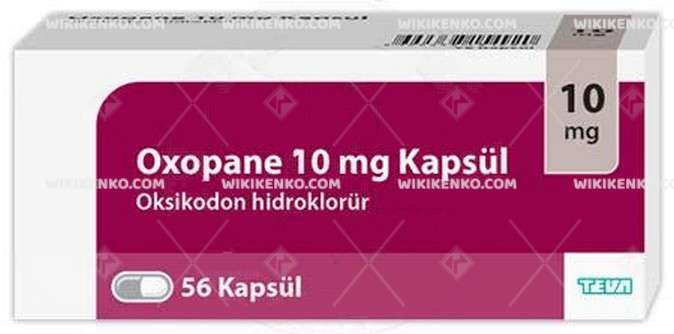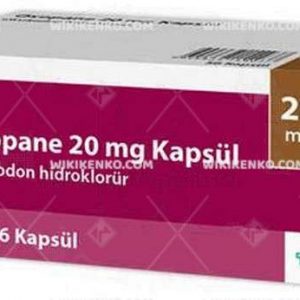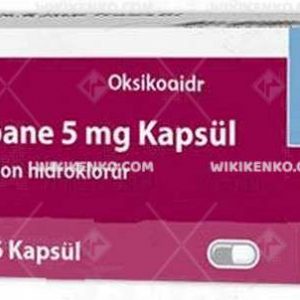Oxopane Capsule 10 Mg
Oxopane, also known as oxymorphone, is an opioid pain medication that is often referred to as a narcotic. It is a potent prescription pain medicine that is used for the management of moderate to severe pain. Here, we will discuss the indications, dosage, pharmacology, and potential side effects.
| Potency | 10 Mg |
|---|---|
| Manufacturer | |
| Origin | |
| Generic Name (Ingredient) | Oxycodone Hydrochloride 10 Mg (Equivalent To 8.96 Mg Oxycodone) |
Assuming your emergency circumstances for this product, visit Urgent Quotation page. Besides, for any pharmaceutical questions, please ask us in the comments section.
Description
Indications
Oxopane is generally prescribed when other treatments such as non-opioid pain medicines are not effective in controlling the pain or if the patient cannot tolerate alternate treatments. Patients with chronic pain should have their dosage given on an around-the-clock basis to prevent the reoccurrence of pain, rather than treating the pain after it has occurred.
Oxopane HYDROCHLORIDE prolonged-release tablets (Oxopane) are approved for the treatment of moderate to severe pain, including steady pain such as cancer pain, paroxysmal spontaneous pain, and allodynia. This prolonged-release oral formulation of its hydrochloride is indicated for the management of moderate to severe pain when a continuous, around-the-clock analgesic is needed for an extended period of time.
Dosage
Oxopane is available as an immediate-release tablet in strengths of 5 mg, 15 mg, and 30 mg. If changing brands of it from immediate-release tablets to extended-release tablets, it must be accompanied by close observation, checking for signs of excessive drowsiness or slow breathing.
Pharmacology
Oxopane is a full opioid agonist with no antagonist properties. Its principal therapeutic action is analgesia. It has an affinity for κ, mu, and δ opiate receptors in the brain and spinal cord. Oxopane is similar to morphine in its action. Other pharmacological actions of it are in the central nervous system, smooth muscle, and cardiovascular system. It can cause respiratory depression, antitussive, anxiolytic, sedative, and miosis in the central nervous system.
It can also cause constipation, reduction in gastric, biliary, and pancreatic secretions, spasm of sphincter of Oddi, and transient elevations in serum amylase in the smooth muscle. In the cardiovascular system, it can cause the release of histamine and/or peripheral vasodilation, possibly causing pruritus, flushing, red eyes, sweating, and/or orthostatic hypotension.
Compared with morphine, which has an absolute bioavailability of approximately 30%, Oxopane has a high absolute bioavailability of up to 87% following oral administration. The absorption of Oxopane from Oxopane tablet is biphasic, with an initial absorption of approximately 40% of Oxopane HCl (T ½ =0.6 hrs), providing onset of analgesia within 1 hr in most patients, followed by a more controlled absorption, which determines the 12-hr duration of action (T ½ =6.2 hrs).
Side Effects
Like all medications, Oxopane can have side effects. Some common side effects may include drowsiness, headache, dizziness, tiredness, constipation, stomach pain, nausea, and vomiting. It is important to note that this is not a complete list of side effects, and others may occur. If you experience any side effects while taking it, you should contact your doctor for medical advice.
Conclusion
Oxopane is a potent opioid medication used for the management of moderate to severe pain when other treatments are ineffective or not tolerated. It is important to follow the prescribed dosage and be aware of the potential side effects associated with its use. While it can be an effective tool in pain management, it should only be used under the guidance of a medical professional. Patients should discuss any concerns or questions they have with their healthcare provider to ensure that they are receiving the best treatment for their individual needs.
Use the form below to report an error
Please answer the questions as thoroughly and accurately as possible. Your answers will help us better understand what kind of mistakes happen, why and where they happen, and in the end the purpose is to build a better archive to guide researchers and professionals around the world.
The information on this page is not intended to be a substitute for professional medical advice, diagnosis, or treatment. always seek the advice for your physician or another qualified health provider with any questions you may have regarding a medical condition. Always remember to
- Ask your own doctor for medical advice.
- Names, brands, and dosage may differ between countries.
- When not feeling well, or experiencing side effects always contact your own doctor.
Cyberchondria
The truth is that when we’re sick, or worried about getting sick, the internet won’t help.
According to Wikipedia, cyberchondria is a mental disorder consisting in the desire to independently make a diagnosis based on the symptoms of diseases described on Internet sites.
Why you can't look for symptoms on the Internet
If diagnoses could be made simply from a textbook or an article on a website, we would all be doctors and treat ourselves. Nothing can replace the experience and knowledge of specially trained people. As in any field, in medicine there are unscrupulous specialists, differences of opinion, inaccurate diagnoses and incorrect test results.





Reviews
There are no reviews yet.